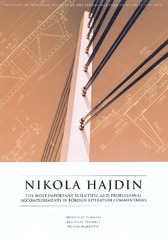Приказ основних података о документу
Nikola Hajdin: the most important scientific and professional accomplishments in foreign literature commentaries : on the occasion of his eighty-fifth birthday
| dc.creator | Šumarac, Dragoslav | |
| dc.creator | Stipanić, Bratislav | |
| dc.creator | Marković, Nenad | |
| dc.date.accessioned | 2019-05-06T20:34:24Z | |
| dc.date.available | 2019-05-06T20:34:24Z | |
| dc.date.issued | 2010 | |
| dc.identifier.isbn | 978-86-80321-24-0 | |
| dc.identifier.uri | http://dais.sanu.ac.rs/123456789/103 | |
| dc.identifier.uri | https://grafar.grf.bg.ac.rs/handle/123456789/1711 | |
| dc.description.abstract | During his long scientific and professional activity spanning over half a century and going through different phases, professor Nikola Hajdin obtained results of greater or lesser significance depending on the state of development of science and technology. This overview singles out the results which, in our opinion and that of scientific criticism, rendered a specific contribution to the progress of science and its applications. It is primarily his written work and his structures, predominantly bridges, which signified greater or lesser headway in these areas. Here we have singled out, first and foremost, works which have been acknowledged and highly acclaimed in the country and abroad and which constitute a scientific or constructive contribution to progress. Professor Hajdin’s choices during studies seemed to indicate that he would devote his whole life to scientific work in the field of applied mechanics, especially structural mechanics. However, he soon realized that any significant and valuable effort in structural mechanics, in addition to a theoretical basis, required extensive knowledge of real structures, their development and tendencies substantially influencing scientific endeavor in this area. He realized at a very early stage that these were simultaneous and interactive processes. Many outstanding structural achievements came into being under the influence and with knowledge of applied mechanics, such as the discoveries of French scientists such as Claude-Louis Navier, Barré de Saint-Venant and others, which extensively transformed practical know-how in the field of structures.A feedback effect is visible everywhere. One of the most important is definitely the method of finite elements which sprang from practical needs and theoretical investigation of structures. There are very many examples of both. Such a perception as well as the need for scientists to tackle practical problems and application in design prompted professor Hajdin to take up designing as a parallel activity, one he initially considered to be more of a hobby, and later a serious and responsible job in which he incorporated upon, as this survey will show, the results of his scientific work, with some of the applications serving to verify scientific results. This will be discussed at length, for it is precisely this combination that is the chief characteristic of his work. If one reads only his articles, monographs and books dealing with theory, one will not always be able to see where specific results applied to structures lead. The creative opus of professor Hajdin can be broadly divided into six periods, i.e. six areas in which he gave a contribution to science and its applications, and one can say, indeed a contribution to general progress. | en |
| dc.format | application/pdf | |
| dc.language | en | |
| dc.publisher | Belgrade : Institute of Technical Sciences of SASA | |
| dc.rights | openAccess | |
| dc.subject | Hajdin, Nikola | |
| dc.subject | civil engineering | |
| dc.subject | bridges | |
| dc.title | Nikola Hajdin: the most important scientific and professional accomplishments in foreign literature commentaries : on the occasion of his eighty-fifth birthday | en |
| dc.type | book | |
| dc.rights.license | ARR | |
| dc.identifier.fulltext | https://grafar.grf.bg.ac.rs//bitstream/id/3657/1709.pdf | |
| dc.identifier.rcub | https://hdl.handle.net/21.15107/rcub_grafar_1711 | |
| dc.type.version | publishedVersion |

